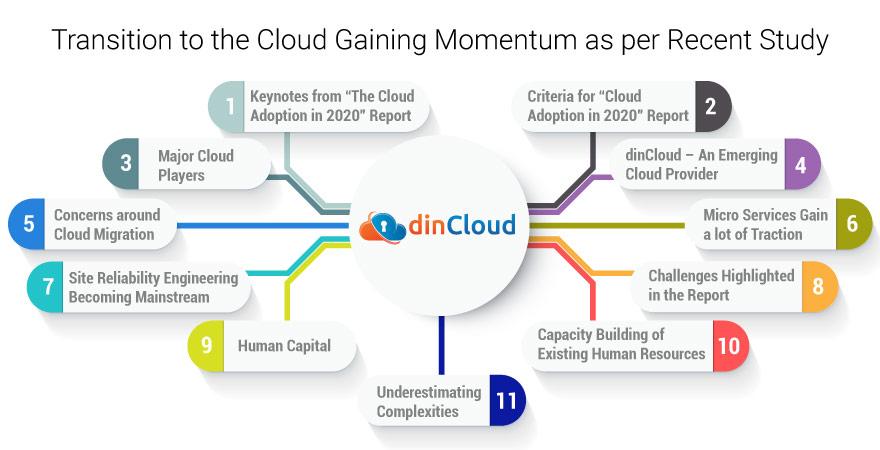Cloud based solutions and services are gaining a lot of momentum as more enterprises realize the inherent benefits. By their very nature, cloud computing solutions have the potential to deliver a highly flexible, scalable and versatile productivity environment.

This trend was revealed in a recent study conducted by “O’Rielly Media”, a reputed technology and business training company. The crux of this study is that organizations intend to shift most of their apps to the cloud by the year 2021.
Keynotes from “The Cloud Adoption in 2020” Report
Below are a few key stats extracted from the comprehensive report about increasing adoption of cloud based solutions and applications:-
- An overwhelming 88% of participants reported they are currently using some sort of cloud solution or service in their organization.
- Over the next one year, 45% of respondents expect to transition a whopping 75% of their current applications to the cloud infrastructure.
- A mere 10% of the study participants said they do not employ any sort of cloud based solution or service in their current IT infrastructure.
Criteria for “Cloud Adoption in 2020” Report
The study conducted by “O’Rielly Media” was based on a broad based sample size of nearly 1,283 vital IT decision makers at various enterprises. Here are a few more important insights from the report:-
- A decent 21% of participating enterprises entirely host their applications over the cloud, which is a very encouraging statistic.
- However, nearly 49% of organizations still rely upon traditional, on premise infrastructure.
- 39% of the study participants reported using a combination of public and private cloud, also known as a hybrid environment.
- A majority 54% of participants reported using a multi cloud environment, which simultaneously relies upon more than one Cloud Service Provider (CSP).
Also Read:
- Adoption of Cloud Backed Communication Solutions on the Rise
- Future-Proof your Business with Cloud Solutions
- Security Benefits of Cloud Computing Solutions
Major Cloud Players
The landscape for major public cloud providers remained fairly unchanged. The largest providers in terms of market share came out as Amazon Web Services (AWS), Microsoft Azure and Google Cloud Platform (GCP) respectively.
dinCloud – An Emerging Cloud Provider
One public cloud provider worth mentioning here is dinCloud, which continued its strong growth. The CSP has been consistently expanding its cloud user base on the back of a robust, secure and reliable cloud infrastructure.
dinCloud has consistently been improving its cyber security posture as well by integrating industry leading solutions. The findings of this study have also revealed that 65% of participants report cloud security as a critical area in their transition to the cloud.
Concerns around Cloud Migration
Now, let’s highlight some areas of concern that were revealed by respondents in this study during the transition to a cloud infrastructure:-
- Cloud security was cited as a critical skill area during the cloud migration by nearly 65% of study participants.
- 58% of respondents regarded monitoring as a key area of concern during and after the migration to some sort of cloud infrastructure.
- Kubernetes related skills, which relate to integrating and optimizing productivity applications were regarded as a necessity by nearly 56% of participants.
Micro Services Gain a lot of Traction
As per the recent report, the trend of micro-services is gaining a lot of momentum. This is an approach to software and application development which focuses on ease of updating, patching and scaling the solution as per changing enterprise needs.
Site Reliability Engineering Becoming Mainstream
According to the study, SRE or Site Reliability Engineering is a technique well on its way to becoming a mainstream technology over the current and upcoming year. This method relies on intelligent software to manage, troubleshoot and automate cloud operations.
Challenges Highlighted in the Report
The comprehensive report also quoted a few challenges that organizations which have migrated to the cloud, or are in the process of doing so must keep in consideration. Some of these issues to watch out for include:-
Human Capital
The report states that most migrating entities focus more on the technical aspects of the cloud transition and in doing so, the human capability part tends to be ignored. Organizations must take account of the requisite skills required for the transition.
As soon as the requisite skill set has been identified, migrating entities must provision the right cloud professionals for the job. In this process, it is also not a bad idea to consider outsourcing some complex aspects of the transition to expert companies or professionals.
Also Read:
- How dinCloud’s Hosted Virtual Desktops Benefit Your Enterprise?
- The Forecast is Clear: Cloud-based Solutions can Free you From On-Premises Burdens
Capacity Building of Existing Human Resources
This was another aspect highlighted by the study. Even if you engage professionals for the transition process, the new infrastructure has ultimately to be managed by the exiting human resources. So, it is imperative to build their capacity and skills alongside as well.
Underestimating Complexities
This was also a key challenge identified by the report. Most migrating entities tend to commit the mistake of taking things for granted and at times, even underestimating the complexities related to the cloud transition.
Any such miscalculation, as per the report, can firstly derail the strict timelines defined for the whole transition process. Secondly, this can result in at times massive cost overruns and other complexities associated with the inability to accomplish a task within the timeline.
Conclusion
The study notes that proper homework before engaging in a cloud transition is of utmost importance. Once the planning phase is complete, the next critical step is identifying the right Cloud Service Provider (CSP) for your needs.
dinCloud is a well established name in the public cloud providers landscape. Our cloud hosted solutions and services are highly reliable. Contact Us for your cloud computing needs and we assure you won’t regret this decision at all.


